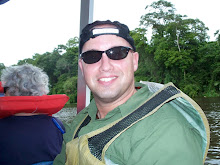Fort Edmonton Park is Canada's largest living history museum and is a fantastic example of "history in motion". An interactive museum spanning many decades of Alberta's capitol city, Fort Edmonton Park has four primary features: 1920 street, 1905 street, 1885 street and the original Fort Edmonton (built in 1795 and shown as a fully functioning post at the height of the fur trade in 1846.
The following photo essay is only a small collection of the photos we took and the experiences we enjoyed that day, but I hope it educates and entertains you with Alberta's history!
 I'd say the sign is pretty self-explanatory...
I'd say the sign is pretty self-explanatory... Fort Edmonton Park entrance. This building is a refurbished (and actively used by the park) railway station.
Fort Edmonton Park entrance. This building is a refurbished (and actively used by the park) railway station. 1920 Street.
1920 Street. Time period automobiles and motordrome, circa 1920.
Time period automobiles and motordrome, circa 1920. 1920 Street.
1920 Street. The cap badge of the Loyal Edmonton Regiment (aka "The Loyal Eddies"). The LER was formed at the start of the First World War as the 49th Battalion, Canadian Expeditionary Force. The motto of the Loyal Eddies is "Fear No Foe".
The cap badge of the Loyal Edmonton Regiment (aka "The Loyal Eddies"). The LER was formed at the start of the First World War as the 49th Battalion, Canadian Expeditionary Force. The motto of the Loyal Eddies is "Fear No Foe".The Loyal Edmonton Regiment still exists as a Reserve Force Regiment in the Canadian Armed Forces, and forms the 4th (Reserve) Battalion of the Princess Patricia's Canadian Light Infantry (PPCLI).
 Talking with a local actor portraying his own grandfather, who fought in the First World War with the Loyal Edmonton Regiment.
Talking with a local actor portraying his own grandfather, who fought in the First World War with the Loyal Edmonton Regiment. This intrepid young man has looked high and low for authentic uniform pieces to complete his post-WW1 uniform, and has almost completed the uniform - at his own cost.
 Typical Edmonton street - including electric streetcars - circa 1905.
Typical Edmonton street - including electric streetcars - circa 1905. Edmonton council chambers circa 1905.
Edmonton council chambers circa 1905. Tent camp where new settlers could stay until they could build a house. Many a shopkeeper, accountant or bank clerk stayed in these tent camps with their families for months at a time.
Tent camp where new settlers could stay until they could build a house. Many a shopkeeper, accountant or bank clerk stayed in these tent camps with their families for months at a time. Bachelor's pads haven't changed much in the last 100+ years.
Bachelor's pads haven't changed much in the last 100+ years. 1885 Street.
1885 Street. Northwest Mounted Police outpost.
Northwest Mounted Police outpost. Typical tack of the NWMP circa 1885.
Typical tack of the NWMP circa 1885. New construction methods for the 1880s.
New construction methods for the 1880s. Bellerose schoolhouse built in the 1880s.
Bellerose schoolhouse built in the 1880s. Typical "land yacht" of the mid-late 1800s which many settlers used to cross the continent before the railway was completed.
Typical "land yacht" of the mid-late 1800s which many settlers used to cross the continent before the railway was completed. Plains Cree trading camp located just outside Fort Edmonton. First Nations members participate as living exhibits of Plains Cree culture at the height of the fur trade at Fort Edmonton.
Plains Cree trading camp located just outside Fort Edmonton. First Nations members participate as living exhibits of Plains Cree culture at the height of the fur trade at Fort Edmonton.









No comments:
Post a Comment